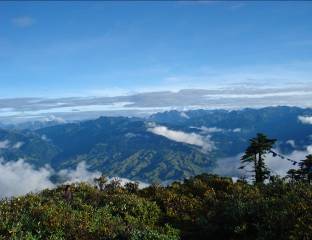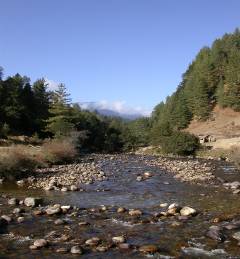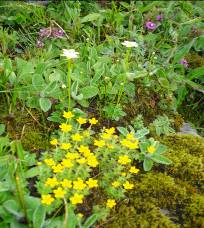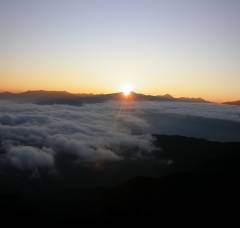Bumthang Owl Trek
Trekking in Bhutan
 The Bumthang Owl Trek offers an invigorating experience of the culture and environment of the country. It is a moderate 3-day hiking route which starts from Menchugang and ends in Jakar Dzong. The trail has an abundance of flora and fauna, and the panoramic views of the valleys beneath the hill tops and the Himalayas spread over a broad horizon would be an experience that one shall cherish for a lifetime. This trek could be a substitute for the Bumthang Cultural Trek that has been deteriorated to a great degree by the farm road constructions.
The Bumthang Owl Trek offers an invigorating experience of the culture and environment of the country. It is a moderate 3-day hiking route which starts from Menchugang and ends in Jakar Dzong. The trail has an abundance of flora and fauna, and the panoramic views of the valleys beneath the hill tops and the Himalayas spread over a broad horizon would be an experience that one shall cherish for a lifetime. This trek could be a substitute for the Bumthang Cultural Trek that has been deteriorated to a great degree by the farm road constructions.
Location: Bumthang
Season: November, December, March, April, May & June
Duration: 3 days and 2 nights
Itinerary:
Day 1:
 Start at Manchugang and visit the biggest village in Bumthang, called Dhur at an elevation of 2900 meters above sea level. The village consists of about 75 households with a recorded population of around 800 people. The single village has three types of inhabitants the Kheps (tax payers) having cattle and farmland, Brokpas (nomads) having Yaks and a third group having either. This village has two different dialects, the usual Bumthang Kha and the Brokke (nomadic dialects). A walk above the village to get the overall view of the village is interesting. Climb down to the river where the traditional water-driven flour mill can be visited. This traditional water driven flour mill used to be a source of livelihood for the people of Dhur village. It has been abandoned after the intake channel was washed away by flashflood. The programme has been rehabilitated as it symbolizes an authentic Bhutanese tradition. Continue the trek uphill through the blue pine forest and reach the camp at Schonath (3450m) in hemlock and juniper forest. The hauling of owls through the night is quite common, hence the name the Owl Trek.
Start at Manchugang and visit the biggest village in Bumthang, called Dhur at an elevation of 2900 meters above sea level. The village consists of about 75 households with a recorded population of around 800 people. The single village has three types of inhabitants the Kheps (tax payers) having cattle and farmland, Brokpas (nomads) having Yaks and a third group having either. This village has two different dialects, the usual Bumthang Kha and the Brokke (nomadic dialects). A walk above the village to get the overall view of the village is interesting. Climb down to the river where the traditional water-driven flour mill can be visited. This traditional water driven flour mill used to be a source of livelihood for the people of Dhur village. It has been abandoned after the intake channel was washed away by flashflood. The programme has been rehabilitated as it symbolizes an authentic Bhutanese tradition. Continue the trek uphill through the blue pine forest and reach the camp at Schonath (3450m) in hemlock and juniper forest. The hauling of owls through the night is quite common, hence the name the Owl Trek.
Day 2:
 Trekking through the virgin forest of huge temperate trees like spruce, hemlock, fir, birch and many species of rhododendron makes you breathe the real wilderness of Bhutan. Bamboos are the main undergrowth of this wild forest. During the months of April and May the rhododendrons are in full bloom. In about two hours, you will arrive at the Drangela Pass (3600m). Ascending the Kitiphu ridge brings you to an altitude of 3870m for the night camp. If weather favors you, have a wonderful view of the valley and the panoramic snow caped Himalayan Mountains. The highest mountain of Bhutan Gangkarpunsum (7541m) stands right in front of you when you are on the peak of Kitiphu (4000m).
Trekking through the virgin forest of huge temperate trees like spruce, hemlock, fir, birch and many species of rhododendron makes you breathe the real wilderness of Bhutan. Bamboos are the main undergrowth of this wild forest. During the months of April and May the rhododendrons are in full bloom. In about two hours, you will arrive at the Drangela Pass (3600m). Ascending the Kitiphu ridge brings you to an altitude of 3870m for the night camp. If weather favors you, have a wonderful view of the valley and the panoramic snow caped Himalayan Mountains. The highest mountain of Bhutan Gangkarpunsum (7541m) stands right in front of you when you are on the peak of Kitiphu (4000m).
Day 3:
 The magnificent sun rise in the morning is a new experience in Bhutan. Climb down to the monasteries of Zambhalha, Chuedak and Tharpaling which brings you to the religious life of monkhood, the historical Buddhist learning centre. Chuedak monastery has 100 Avoloketeshvaras in the form of Chukchizhey (eleven heads) that you will see nowhere else in the country. Afternoon, walk along the ridge of Kikila and finally follow the traditional trek route between Trongsa and Bumthang (the Royal Heritage Trail). The best view of Jakar Dzong will end your three day trek with many interesting and unforgettable memories.
The magnificent sun rise in the morning is a new experience in Bhutan. Climb down to the monasteries of Zambhalha, Chuedak and Tharpaling which brings you to the religious life of monkhood, the historical Buddhist learning centre. Chuedak monastery has 100 Avoloketeshvaras in the form of Chukchizhey (eleven heads) that you will see nowhere else in the country. Afternoon, walk along the ridge of Kikila and finally follow the traditional trek route between Trongsa and Bumthang (the Royal Heritage Trail). The best view of Jakar Dzong will end your three day trek with many interesting and unforgettable memories.
Other information:
On this trek you have the opportunity to see:
- Village life in a very big village like Dhur.
- The virgin temperate forest of blue pine, hemlock, fir, spruce, juniper with undergrowth of bamboo spices, rhododendrons, birch, maple, chestnut and many others. In spring the rhododendrons flowers are in bloom that beautifies the whole trek route.
- The valley views and the Himalayan snow caped mountains in the north.
- Birds of different spices, among them the big monal pheasants can be sighted around the second camp and Tharpaling area during mornings and evenings.
- The Monastry life in Tharpaling, Choedak and Zhambala are yet very interesting.















